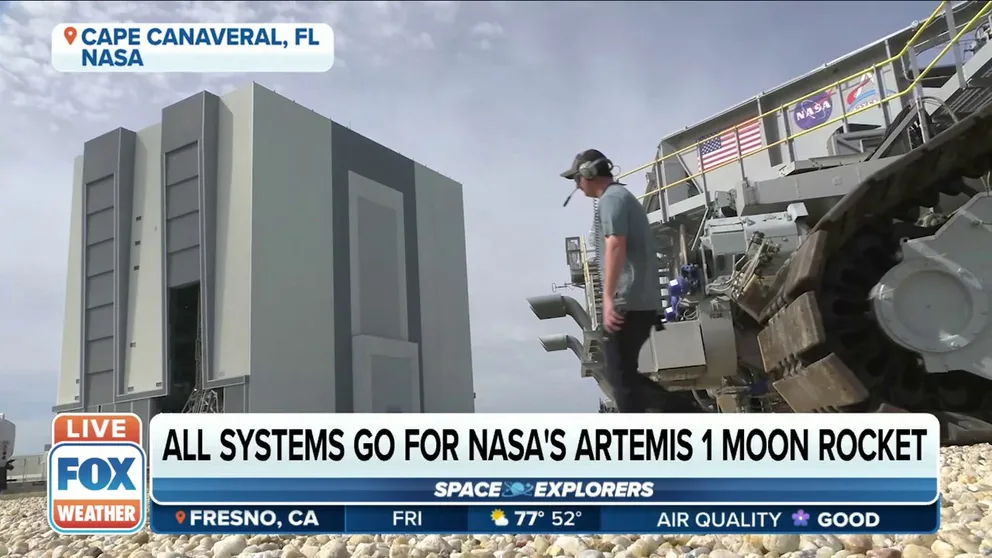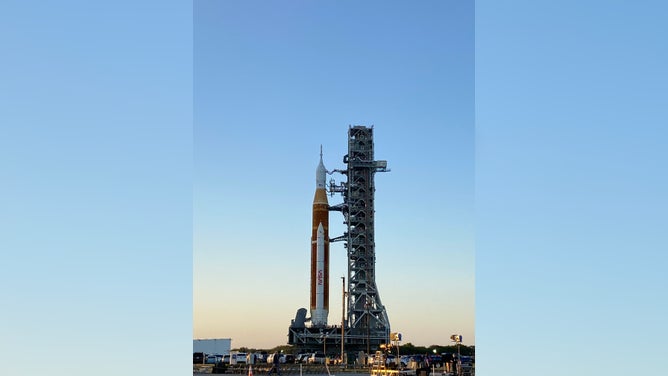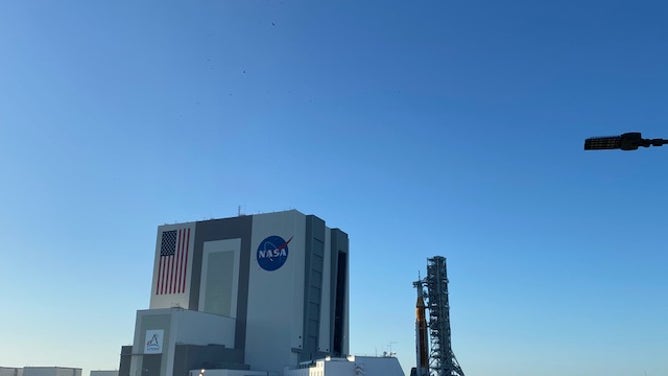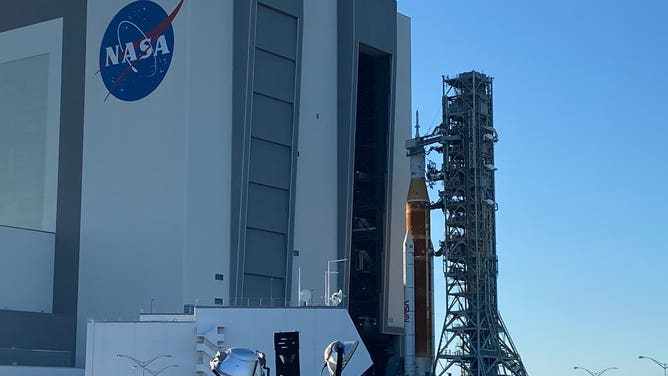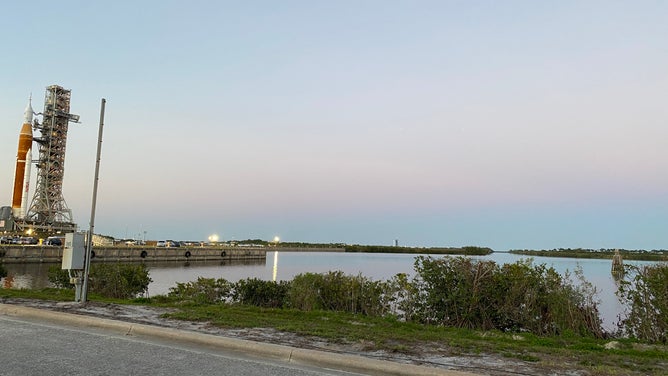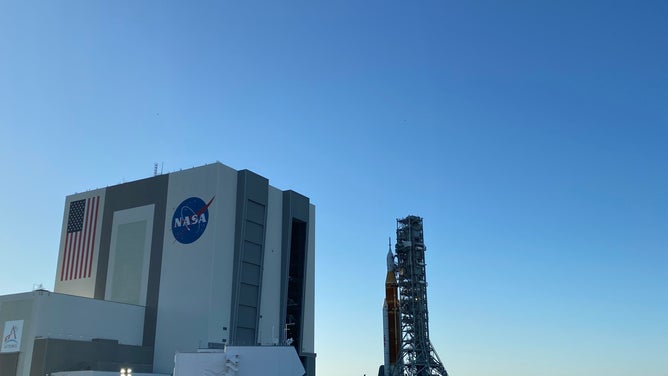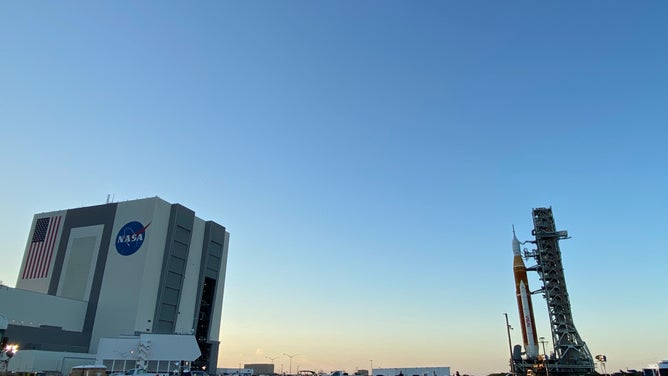NASA's mega moon rocket rolls 'slow and steady' to Kennedy Space Center launchpad
Artemis-1 is the first moon-class rocket to roll out of the VAB since 1972
Artemis-1, NASA's new mega moon rocket heads to launchpad
FOX Weather digital content producer Emilee Speck speaks with FOX Weather multimedia journalist Brandi Campbell on the next rocket to carry astronauts to the moon.
KENNEDY SPACE CENTER, Fla. – As the doors rolled up, revealing the next rocket to return NASA astronauts to the moon, it was like the beginning of a parade decades in the making.
Since the fall, the Space Launch System rocket and Orion spacecraft have been stacked inside the Vehicle Assembly Building, awaiting the Artemis-1 mission launch. For the first time, the Artemis-1 vehicle is making the 4-mile journey from the Vehicle Assembly Building to launchpad 39B on Thursday, marking one of the final trips on Earth for the 322-foot-tall moon rocket. When the rocket arrives at the launch site, it will stay firmly on the ground until after a wet dress rehearsal.
Many team members who have worked on SLS and Orion were gathered at Kennedy Space Center for the big day, along with some of their family and plenty of news media. A marching band was set up near the VAB and buses of viewers were brought out for the occasion. Everyone was excited to see the rocket in the Florida sun outside the hangar.
The first movement was slated to start at 5 p.m. but by 5:35 p.m. the massive mobile launch tower hadn't moved and the University of Central Florida marching band was on standby. At 6 p.m., the journey actually began, and the band started to play.
Lockheed Martin engineer Chelsea Partridge has been working on the Orion spacecraft for seven years. She is one of the thousands of people who have contributed to the Artemis program to return humans to the moon for the first time in 50 years.
"This is like the public display to the world of the world's most powerful rocket with the spacecraft that's going to get us back to the moon on top," engineer Chelsea Partridge said. "There is nothing more exciting, at least so far in my career, than this."
As the rocket moved out of the VAB, the Orion was at the very top. This one won't carry humans, but Partridge says Lockheed Martin is working on the Artemis-2 and Artemis-3 vehicles that will carry astronauts.
"We have Artemis-1 that you'll be seeing today on top of the SLS rocket, but we actually have two other Orion spacecraft here at Kennedy Space Center in two different phases of build right now," she said. "We have Artemis-2 and Artemis-3, both of which will carry Crew."
Artemis-1 will launch without crew and send Orion on a moon orbit before the spacecraft returns, splashing down at sea. By Artemis-3, the spacecraft will carry the first astronauts to the moon. NASA plans to make that happen by 2025.
Getting the SLS out of the hangar and on the move is a carefully planned event. The crew access arm must be moved to fit the SLS through the bay doors.
"We're going to swing it back and locking into a position that's called the crew access arm, and it has the white room where the astronauts will be able to enter the vehicle. We actually have to have it open when we go out the door that we got to swing it back," said Jeremy Parsons, deputy manager of Exploration Ground Systems at NASA Kennedy Space Center.
After that, the crawler transporter-2 with the rocket and mobile launch tower will move at a cruising speed of 2 mph. The trip to the launchpad will take about 11 hours.
"Then it's pretty much full-on out. We'll go a little bit slower around the turn out to the launch pad," Parsons said. "Otherwise, it's going to be slow and steady wins the race for us."
Parsons said many people had worked long hours to get to this point and sacrificed time with their families, including his own. Ahead of the rollout, he said he was most looking forward to having his 8 and 10-year-old daughters there to see it.
"I just want to see their faces when they see this come out," Parsons said. "Their family has worked out here for some time. They've seen a lot of sacrifices, and I think that moment is what I'm looking forward to make it all worthwhile."
Thursday's move to the launchpad will culminate with a wet dress rehearsal in early April when mission managers run the SLS through the paces in the final test before liftoff. After Artemis-1 arrives at launchpad 39B, teams prepare the rocket for launch just like they will when it blasts off to the moon.
"The first thing we do is we set it down, and we start hooking up power, water and conditioned air. Overall, what we're marching towards is what's called a wet dress rehearsal," Parsons explained. "We want to tank the vehicle with all these cryogenic fuels, if you will, that we're going to use for launch. And so we want to take it all the way up. We want to make sure everything works."
The test will run the countdown to T-minus 10 seconds. After the test, the rocket will make the slow journey back to the VAB before teams get to do it all over again for the actual liftoff targeted for June.
